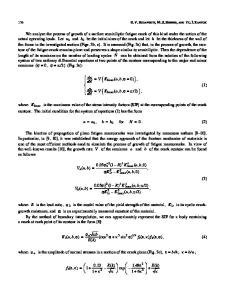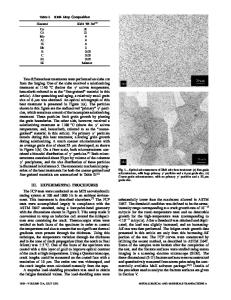Fatigue crack propagation in Ni-base superalloy single crystals under multiaxial cyclic loads
- PDF / 2,714,329 Bytes
- 12 Pages / 594 x 810 pts Page_size
- 67 Downloads / 514 Views
I.
INTRODUCTION
SINGLE crystal nickel-base superalloys are increasingly utilized in advanced gas turbine engine applications because of superior creep-rupture properties. In contrast to conventionally cast alloys, the mechanical properties of the single crystal superalloys are highly anisotropic. High- and low-cycle fatigue behavior has been characterized for columnar-grained and single crystal superalloys as a function of temperature, 1'2 frequency, 3 and microstructure. 4 A significant result of these studies on single crystals is that extended crystallographic cracking on {111} planes, Stage I fatigue, 5 can be expected at all cyclic frequencies for temperatures up to ~760 °C and at even higher temperatures for engine excitation frequencies. 3 Extended Stage I crack growth in single crystal Ni-base superalloys is characterized by cracking along intense coplanar {111} slip bands with the fracture surface manifesting a cleavage-like appearance, suggesting that normal stresses are important in this fracture process. This fracture behavior, also observed in age-hardenable A1 alloys, 6'7 alpha and beta Ti alloys, s'9 is contrary to the observation in polycrystalline materials that Stage I crack growth, which is dominated by the cyclic shear stress range, would experience a transition to the normal-stress-dominated Stage II crack growth when the ratio of normal stress to shear stress becomes large. 5 On the other hand, a recent fracture model ~°'11 suggests that extended Stage I crack growth and the associated cleavage-like fracture surface appearance is the consequence of the crack-tip plasticity, and, in particular, the inability of coplanar slip to relax the normal stress components of the crack-tip stress field. While many features of extended Stage I crack growth have been identified in single crystal Ni-base superalloys, very little, if any, information is available on the influence *MAR-M is a trademark of Martin Marietta Company. K. S. CHAN, Senior Research Engineer, and G. R. LEVERANT, Director, Department of Materials Sciences, are with Southwest Research Institute, 6220 Culebra Road, San Antonio, TX 78284. J.E. HACK, formerly with Southwest Research Institute, is now a Bernd T. Matthias Fellow at Los Alamos National Laboratory, Los Alamos, NM 87545. Manuscript submitted February ! 9 , 1985. METALLURGICALTRANSACTIONS A
of crystallographic orientation and stress state on the crack growth behavior. The influence of anisotropy on subcritical crack growth has been studied only for columnar-grained material under thermal-mechanical cycling. 12 A recent study 13 examined the crack growth behavior of [001] single crystals at ambient as well as elevated temperatures, but the effects of crystallographic orientation and stress state were not investigated. In an attempt to establish an understanding of the effects of crystallographic orientation and stress state, the present study, therefore, examines the crack growth behavior of single crystals of a Ni-base superalloy, MARM200, under multiaxial cyclic loads.
II.
Data Loading...











